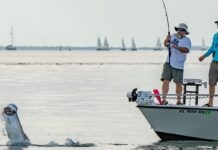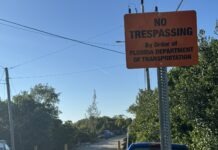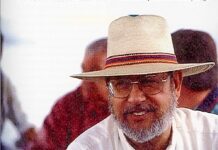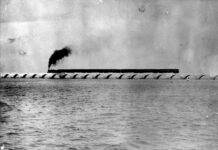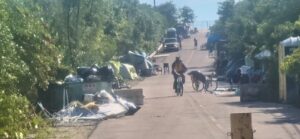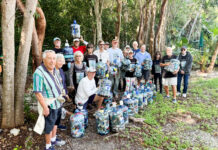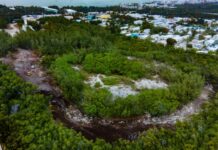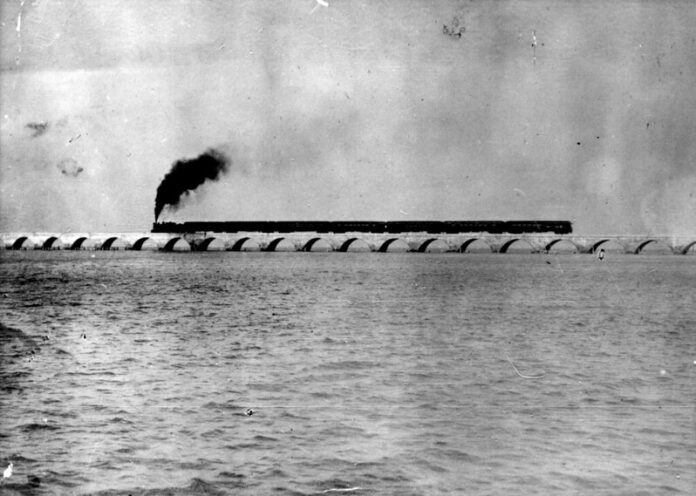
Driving along the Overseas Highway through the Florida Keys, it is easy to have your sense of direction confused. When entering Key Largo and heading down the island chain like birds for the winter, it seems like you should be traveling south. Conversely, leaving the island chain and driving back to the mainland, the natural inclination is to think you are moving north.
A compass will indicate that you are mistaken. The island chain does not fall away from the peninsula in a straight line but a long, sweeping curve. Key Largo, at the top of the highway, roughly aligns with Miami and the east coast. At the other end of the highway, Key West is located west of Fort Myers, a city that borders Florida’s other coast.
The two, Key West and Fort Myers, share an interesting connection. Once upon a time, both were part of a substantially larger Monroe County. When it was established in 1823, the county stretched from the county seat at Key West north to Lake Okeechobee and west to Port Charlotte — about 30 miles north of Fort Myers. In 1885, when Fort Myers, population 349, incorporated, it became the second city in Monroe County to do so. Key West, the first, did it in 1828.
Getting back to the highway and the discussion about the direction it travels, north and south or east and west, it is the latter. For instance, when the highway rolls away from Long Key in the direction of Key West, it leaves the island’s west end. It does a couple of other things, too, one of which is more concrete than the other. The somewhat abstract thing that occurs when driving away from Long Key is that you enter a relatively undefined area where the Upper Keys end and the Middle Keys begin.
The conduit used to link the two geographical areas is the Long Key Bridge, of which there are two. There is the bridge accommodating the cars driving back and forth across it today and the one that supported the railroad tracks that delivered Henry Flagler’s train back and forth between Key West and the mainland. Both offer spectacular, unobstructed views. Both versions of the bridge are the second longest of the bridges connecting the island chain to the mainland.
The old railroad bridge is actually called the Long Key Viaduct. Merriam-Webster defines a viaduct as “a long elevated roadway usually consisting of a series of short spans supported on arches, piers or columns.” Viaducts were used to build 26 railroad bridges between Lower Matecumbe Key and Key West.
The 2.7-mile-long Long Key Viaduct was built with 215 50-foot arches. One of the most difficult of all the bridges to make, the engineering marvel was Henry Flagler’s favorite. Also, the Long Key Viaduct’s likeness was used to represent the Florida East Coast Railway on its logo for the Key West Extension. It is also used in the logo of the Monroe County Library System.
The viaduct, completed in 1913, served the needs of the railroad until the arrival of the 1935 Labor Day Hurricane on September 2. While the hurricane destroyed 40 miles of railroad tracks, many of the bridges supporting them withstood the tremendous impacts of the storm. When the second version of the Overseas Highway opened to traffic in 1938, many of the railroad bridges had been widened to accommodate cars and trucks, including the Long Key Viaduct.
For 44 years, Flagler’s favorite bridge supported automobile traffic. In 1982, the old railroad viaduct was retired and replaced by the bridge we drive along today. The old Long Key Viaduct is still open to traffic as part of the Florida Keys Overseas Heritage Trail — foot and bicycle traffic. In the morning, noon and night, fishermen can be seen on the viaduct, standing guard over their poles and waiting for that curious twitch the line does when a fish shows interest in the tasty morsel at the other end.
The Florida Keys Overseas Heritage Trail is a paved path covering more than 90 miles that parallels the Overseas Highway between Key Largo and Key West. Many of the old railroad bridges have been incorporated into the trail. Not all of them – after more than 100 years, some of the old bridges are barely safe for the pelicans, cormorants and seagulls that gather on them.
Both versions of the Long Key Bridge end at Conch Key, the beginning of the Middle Keys. There are two Conch Keys, Conch Key and Little Conch Key. Conch Key, where the bridge ends, is a lot bigger now than it was when Henry Flagler’s train used to roar up and down the tracks. The “real” Conch Key is located on the Gulf side of the highway. The other part of the island, found on the Atlantic side of the highway, did not come into existence until the late 1950s. The dredge and fill project was completed by 1959.
In the meantime, there are more islands, bridges, and fill to explore on the Great Florida Keys Road Trip.
In 2025, I’ll be exploring the Overseas Highway, its history, attractions, and points I find interesting.


